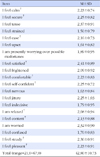Abstract
Purpose
The Purpose of this study was to investigate relationships between maternal fetal attachment and state anxiety for pregnant women in preterm labor.
Methods
The subjects consisted of 56 pregnant women in preterm labor on C hospital. The data were analyzed using SPSS computer program that includes descriptive statistics, mean, standard deviation, t-test, ANOVA, Scheffe? test and Pearson correlation coefficient.
Results
Age distribution was 30~39 years of age. Mean score of maternal fetal attachment was 91.50. The group whose planned pregnancy was highest showed higher maternal fetal attachment. The primigravida group showed high maternal fetal attachment. Most frequently practiced attachment item was: "I'm really looking forward to seeing what the baby looks like". The next was was: "I enjoy watching my tummy jiggle as the baby kicks inside". There was no difference in degree of anxiety by general and obstetrical characteristics. There was statistically significant of negative correlation between maternal fetal attachment and state anxiety for pregnant women with preterm labor.
Figures and Tables
Table 1
General Characteristics by Subjects and Difference of Fetal Attachment Behavior and State Anxiety by General Characteristics (N=56)

References
1. Alder J, Fink N, Bitzer J, Hosli I, Holzgreve W. Depression and anxiety during pregnancy: A risk factor for obstetric, fetal and neonatal outcome? A critical review of the literature. J Matern Fetal Neonatal Med. 2007; 20:189–209. http://dx.doi.org/10.1080/14767050701209560.

2. Alhusen JL, Gross D, Hayat MJ, Woods AB, Sharps PW. The influence of maternal-fetal attachment and health practices on neonatal outcomes in low-income, urban women. Res Nurs Health. 2012; 35:112–120. http://dx.doi.org/10.1002/nur.21464.

3. Chang SB, Kim HS, Ko YH, Bae CH, An SE. Effect of abdominal breathing on anxiety, blood pressure, peripheral skin temperature and saturation oxygen of pregnant women in preterm labor. Korean J Women Health Nurs. 2009; 15:32–42. http://dx.doi.org/10.4069/kjwhn.2009.15.1.32.
4. Choi MS, Park YJ. The effect of relaxation therapy on anxiety and stress of pregnant women with preterm labor. Korean J Women Health Nurs. 2010; 16:336–347. http://dx.doi.org/10.4069/kjwhn.2010.16.4.336.
5. Cranley MS. Development of a tool for the measurement of maternal attachment during pregnancy. Nurs Res. 1981; 30:281–284.

6. Cunningham FG, Gant NF, Leveno KJ, Gilstrap LC, Hauth JC, Wenstrom KD. Williams obstetrics. 21st ed. New York: McGraw-Hill Co;2001.
7. Erdfelder E, Faul F, Buchner A. G Power: A general power analysis program. Behav Res Methods Instrum Comput. 1996; 28:1–11.
8. Go JI, Kim KH, Yeoum SG. Relationship with physical suffering, emotional state, and nursing needs of pregnant women with pretrem labor. Korean J Women Health Nurs. 2009; 15:280–293. http://dx.doi.org/10.4069/kjwhn.2009.15.4.280.
10. Ha SE. The relation between the level of marrige satisfaction of pregnant women and the degree of prenatal care practices. Seoul: Sookmyung Women's University;2004. Unpublished master's thesis.
11. Hwang RH. A study on the relationship between state anxiety and maternal fetal attachment in the pregnant women. Nonmunjip-Gwangjuyeojadaehakgyo. 2000; 3:429–449.
12. Hwang RH. A study on the relationship between state anxiety and maternal fetal attachment of unmarried mothers in a welfare center. Korean J Women Health Nurs. 2005; 11:218–224.

13. Kang SK, Chung MR. The relationship between pregnant woman's stress, temperament and maternal-fetal attachment. Korean J Hum Ecol. 2012; 21:213–223. http://dx.doi.org/10.5934/KJHE.2012.21.2.213.

14. Kim HO. Maternal-fetal attachment behaviors during pregnancy. Seoul: Yonsei University;1991. Unpublished master's thesis.
15. Kim HS. Patterning of parent-fetal attachment during the experience of guided imagery: An experimental of Martha Rogers human-environment integrality. New York: Columbia University;1990. Unpublished doctoral dissertation.
16. Kim JI. Comparison of prenatal education programs for the primigravida - focused on anxiety and labor efficacy. Korean J Women Health Nurs. 2005; 11:225–231.
17. Kim JT, Shin DK. A Study based on the standardization of the STAI for Korea. New Med J. 1978; 21:65–75.
18. Kwon MK, Bang KS. Relationship of prenatal stress and depression to maternal-fetal attachment and fetal growth. J Korean Acad Nurs. 2011; 41:276–283. http://dx.doi.org/10.4040/jkan.2011.41.2.276.

19. Lee MK. Factors influencing self confidence during delivery in laboring women. Korean J Women Health Nurs. 2005; 11:20–26.

20. Lee PS. A study on the physical and emotional status, nursing need and performance of the premature labor women. Seoul: Hanyang University;1995. Unpublished master's thesis.
21. Morrison JC, Roberts WE, Jones JS, Istwan N, Rhea D, Stanziano G. Frequency of nursing, physician and hospital intervention in women a risk for preterm delivery. J Matern Fetal Neonatal Med. 2004; 16:102–105. http://dx.doi.org/10.1080/jmf.16.2.102.105.
22. Parkes CM, Stevenson-Hinde J. The place of attachment in human behavior. New York: Basic Books;1982.
23. Resnik R. Issues in the management of preterm labor. J Obstet Gynaecol Res. 2005; 31:354–358. http://dx.doi.org/10.1111/j.1447-0756.2005.00302.x.

24. Ryu KH, Shin HS. Phenomenological study on experience of preterm labor. Korean J Women Health Nurs. 2009; 15:140–149. http://dx.doi.org/10.4069/kjwhn.2009.15.2.140.

25. Schore AN. Effects of a secure attachment relationship on right brain development, affect regulation, and infant mental health. Infant Ment Health J. 2001; 22:7–66. http://dx.doi.org/10.1002/1097-0355(200101/04)22:1<7::AID-IMHJ2>3.0.CO;2-N.

26. Spielberger CD, Gorsuch RL, Lushene RE. Manual for the state - trait anxiety inventory. CA: California Consulting Psychologist Press;1970.
27. Statistics Korea. Birth statistics in 2011. 2012. 08. Retrieved June 3, 2013. from http://kostat.go.kr.
28. Stutzman SS, Brown CA, Hains SM, Godwin M, Smith GN, Parlow JL, et al. The effects of exercise conditioning in normal and overweight pregnant women on blood pressure and heart rate variability. Biol Res Nurs. 2010; 12:137–148. http://dx.doi.org/10.1177/1099800410375979.

29. Susan SR. Essentials of maternity, newborn, and women's health nursing. 2nd ed. Philadelphia: Lippincott Williams & Wilkins;2008.
30. Yarcheski A, Mahon NE, Yarcheski TJ, Hanks MM, Cannella BL. A meta analytic study of predictors of maternal-fetal attachment. Int J Nurs Stud. 2009; 46:708–715. http://dx.doi.org/10.1016/j.ijnurstu.2008.10.013.




 PDF
PDF ePub
ePub Citation
Citation Print
Print






 XML Download
XML Download